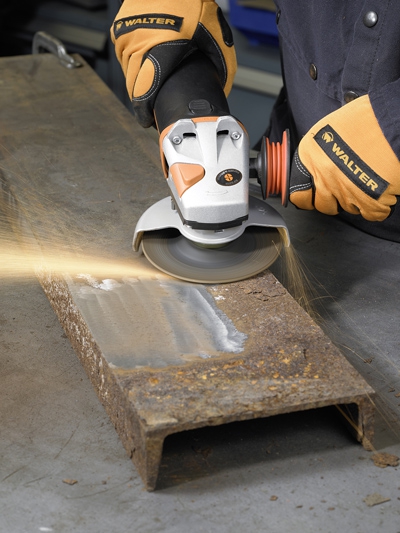
Walter Surface Technologies introduced the FLEXCUT MILL SCALE grinding wheel. The new FLEXCUT MILL SCALE has an innovative product design that improves mill scale removal and takes the hassle out of the mill scale removal process, according to the company. The FLEXCUT MILL SCALE is a premium-performance flexible grinding wheel that is specially formulated to prevent glazing or disc clogging and uniquely designed with a wider surface contact area for faster and easier mill scale removal.
"Iron oxide or mill scale removal is often a tough, time-consuming and costly undertaking. The hassles involving dust-clogged discs and frequent disc changeovers lead to lost productivity. Walter has successfully created the new FLEXCUT MILL SCALE grinding wheel to eliminate abrasive glazing or clogging, while ensuring a hassle-free mill scale removal experience. Users will benefit from significant time and costs savings by using this premium product," says Marc Brunet Gagne, Product Manager, Walter Surface Technologies.
With a unique blend of highly refined, friable abrasives paired with its open diamond cut pattern, FLEXCUT MILL SCALE is designed to grind off mill scale rapidly and will self-dress to avoid clogging.
In addition to removing mill scale, FLEXCUT MILL SCALE features a FE-Free formulation guaranteed to not contaminate aluminum and is very effective when used for rust removal on heavily rusted plates, aluminum or galvanized metal, ensuring a clean and even surface every time.
Contact Details
Related Glossary Terms
- abrasive
abrasive
Substance used for grinding, honing, lapping, superfinishing and polishing. Examples include garnet, emery, corundum, silicon carbide, cubic boron nitride and diamond in various grit sizes.
- grinding
grinding
Machining operation in which material is removed from the workpiece by a powered abrasive wheel, stone, belt, paste, sheet, compound, slurry, etc. Takes various forms: surface grinding (creates flat and/or squared surfaces); cylindrical grinding (for external cylindrical and tapered shapes, fillets, undercuts, etc.); centerless grinding; chamfering; thread and form grinding; tool and cutter grinding; offhand grinding; lapping and polishing (grinding with extremely fine grits to create ultrasmooth surfaces); honing; and disc grinding.
- grinding wheel
grinding wheel
Wheel formed from abrasive material mixed in a suitable matrix. Takes a variety of shapes but falls into two basic categories: one that cuts on its periphery, as in reciprocating grinding, and one that cuts on its side or face, as in tool and cutter grinding.
- milling machine ( mill)
milling machine ( mill)
Runs endmills and arbor-mounted milling cutters. Features include a head with a spindle that drives the cutters; a column, knee and table that provide motion in the three Cartesian axes; and a base that supports the components and houses the cutting-fluid pump and reservoir. The work is mounted on the table and fed into the rotating cutter or endmill to accomplish the milling steps; vertical milling machines also feed endmills into the work by means of a spindle-mounted quill. Models range from small manual machines to big bed-type and duplex mills. All take one of three basic forms: vertical, horizontal or convertible horizontal/vertical. Vertical machines may be knee-type (the table is mounted on a knee that can be elevated) or bed-type (the table is securely supported and only moves horizontally). In general, horizontal machines are bigger and more powerful, while vertical machines are lighter but more versatile and easier to set up and operate.






